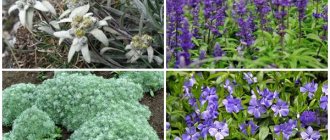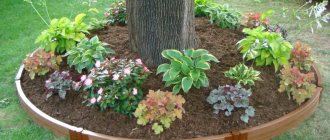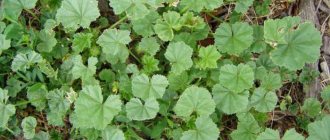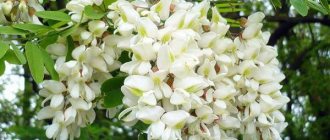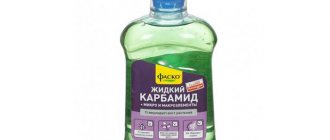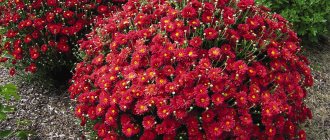Do you want to enjoy wildlife in your home all year round? Now this is possible – even if the temperature in your region drops to -20C. A garden created in greenhouse conditions will retain the warmth and positive emotions of summer!
The winter garden is one of the most popular vacation spots among owners of private houses with above-average income (in any case, such beauty does not come cheap). But it’s worth it - the emotions that this miracle will give you will pay off in full!
The availability of material resources to implement such a large-scale project does not mean a successful solution to the issue. Before you start creating this man-made splendor, you need to decide what plants you will plant and how to place them in the room reserved for the winter garden.
You will need to decide for yourself: what will your man-made garden be like? How do you see it? You need to think through everything carefully, since you are taking responsibility for the “tropical sissies”!
What a winter garden is for - everyone decides for himself!
First you need to make a decision for yourself: what do you and your family hope to get from a winter garden? A place where it would be pleasant to sit, reflect on life, read a book, drink a cup of tea surrounded by greenery, chat with good interlocutors, or have a romantic evening? Plants living in an atmosphere of care and love themselves begin to emit positive energy that will put you in the right mood! This is exactly what a creative person needs - a man-made source of inspiration...
Or do you want to see the illusion of a real tropical forest, close to reality, with rare species of flowers, vines and other vegetation blooming in abundance? An option suitable for expressive and emotional people.
There are many design options and concepts, but the design of the garden and the space allocated to it in the house will be determined exactly how you see it. The choice of plants is also dictated by the location and area of the winter garden! After all, this implies some kind of individual conditions. They suit some plants, not so much others.
Let's look at several popular solutions in central Russia. At the same time, we will learn what plants can be planted and how to place them in each option considered.
Beauties flower: hibiscus
Hibiscus will be an excellent addition to the winter garden. It is especially suitable for those who dream of creating a Mediterranean corner in the greenhouse. It is better to plant the plant in a place where it will have enough light - in the south, southwest and southeast.
Indispensable companions of hibiscus are rose and lavender.
It is believed that hibiscus has strong love energy. That is why any married couple is recommended to plant it in their winter garden. Then harmony and comfort will always reign in your family.
Winter garden - like a full-fledged room
This project involves maintaining constant temperature and humidity conditions throughout the year. The only thing that distinguishes such a garden from other residential premises is the emphasis on flora, which creates the image of the space and divides it into zones.
Conditions: it is necessary to ensure a temperature in the range of 20-25°C and a humidity level of at least 70%.
What plants can be grown in such conditions? This option is suitable for recreating man-made tropics, where heat-loving tropical sissies such as Saintpaulia, Dieffenbachia, Alocasia and even anthurium will feel and develop ideally! It’s a good idea to place two ficus trees near the entrance to the garden as a living frame.
It would be a good idea to dilute the flora with crops that can grow in the shade zone. At the same time, they look no less luxurious than all other tropical flowers. Just look at the unearthly beauty of the Gloriosa liana, entangling the trellises allotted to it with its delicate curls. As well as aquatic plants that feel comfortable near man-made reservoirs: miniature nymphea, cannas and callas.
A small orchard of tropical plants can be an alternative (it is possible to grow only tub crops).
Now it’s time to think about the pearls of your winter garden. The optimal option is gusmania, freesia and neoregelia blooming for 3-4 months in a row.
What is important to consider during the implementation of this winter garden project:
- Priority is life support systems. They must work like clockwork, since almost all plants from this group can die even as a result of a slight temperature difference. Tropical sissies are completely unsuited to living in harsh conditions. Therefore, if you want to admire their beauty, create the proper conditions for them!
- Penumbra. Tropical flowers are accustomed to living under the shade of palm trees. The bright sun and direct exposure to the rays are destructive for them. You can install blinds or hang curtains on the windows.
- Availability of a forced ventilation system.
- For all tropical plants, it is important to provide at least 12 hours of additional light per day in winter and late autumn.
Winter garden on an insulated veranda
An alternative option for a winter garden is a room used as a living space only in the warm season. Here the air will be drier, so organizing a rest room is the best option. Staying in tropical humidity is not an acquired taste! Staying in such a room for a long time is harmful to health, especially for an unprepared person.
Requirements: In the cold season, the temperature range should be within 15°–17° C. The permissible humidity value in summer is up to 75%.
What plants can be grown in such conditions? The premises considered may be suitable for a subtropical garden, the plants of which are much cheaper and not so capricious. Liviston palms, rapis and chrysalidocarpus will feel great under this regime.
To form vertical compositions, it is best to use spectacularly flowering vines: philodendron, passionflower and mandevilla. Begonia and dracaena will also feel good here.
Interesting moment! For some plants, a summer “business trip” to the winter garden on the veranda will only be beneficial. For example, Scherzer's Anthurium, Sprenger's asparagus and Wallis's spathiphyllum will bloom more actively and abundantly in this case.
What to consider? In the winter garden, equipped on the veranda, it is necessary to maintain the temperature regime in winter. There should be no sudden changes, especially drafts. Automating your irrigation system is a convenient option. But remember: you need to water much less often in winter than in summer. You also can’t do without lighting. Otherwise, the plants will lose their decorative value. A rational solution is to plant more unpretentious plants closer to the window. This will shade the garden on overly sunny days, because exposure to direct sunlight will be the hardest test for almost every heat-loving plant.
Mysterious and unique passionflower
Don’t forget about winter garden plants such as passionflower. The liana blooms almost non-stop.
Another name for the plant is “Cavalry Star”. Blue passionflower blooms until frost. When fertilized, growth can reach a meter per week!
Passionflower is photophilous. The optimal room temperature in winter should reach 13 degrees. In summer, watering should be plentiful. In winter it is reduced. If the plant stems become too long, they are shortened. Despite its very exotic appearance, the flower is easy to care for.
Winter garden - greenhouse
This option has advantages not only in design and decorative terms, but also in functionality. It will provide opportunities for growing heat-loving plants, and also optimize the balanced temperature regime of the room. The house itself will become less drafty. In winter, temperatures should be maintained in the range of 10-12° C.
Despite the fact that the greenhouse maintains a cool atmosphere, many southern plants survive the dormant period here remarkably well. Resident of greenhouses No. 1 - rhododendron. Laurel and eucalyptus keep him company. A wonderful “bonus” to them, creating the desired landscape, are ferns.
In addition, the flora of your greenhouse can be diversified with the following “residents”:
- Aloe;
- Forest cacti;
- Sansevieria;
- Clivia.
Even natives of the subtropics will feel good in your greenhouse: lemon, tangerine and kumquat. Provided proper care is taken, they will delight you with their fruits!
What should you pay attention to? As in the winter garden option considered before, the main tasks boil down to maintaining a stable temperature regime without significant jumps, drops and drafts.
Adjustment of the irrigation system should also be carried out depending on the season. The need for additional lighting in the cold season arises to maintain the decorative appearance of plants: otherwise the stems will stretch, the leaves will become smaller, and the tropical flower itself will turn towards the window.
It is advisable to change the composition of the winter garden-greenhouse from month to month. For example, in winter, it makes sense to hide pelargonium in the twilight (until the first sunny days arrive). In November, hedychium will keep her “company”. Rhododendron - their antagonist - will begin flowering in December-February, as soon as bougainvillea fades. It makes sense to keep indoor roses from October to February in a room with a temperature of 15-17C, and with the beginning of the growing season move them to a warmer place. Fuchsia, from a bright flower that pleases the eye with its beauty from spring to autumn, will become shy in winter. It makes sense to send her “to secondary roles” with the onset of cold weather.
There is a subscription service for winter gardens. It involves setting up and correcting the functioning of automated microclimate maintenance systems, feeding and treating plants, maintaining their decorative appearance and, if necessary, replanting. If you have never dealt with indoor plants, find out more about this service.
The location of the winter garden is another point that needs to be taken into account when choosing flora representatives. First, it is better to familiarize yourself with the recommended species composition of plants, their location, and only then sit down to develop the project. It will be unpleasant if, due to an unfortunate location, you cannot grow your favorite plants for which you started all this!
You also need to make adjustments to the location of the winter garden when designing areas of man-made plantings. Perhaps this point is even more important than the choice of plant species. It allows you to level out all the prohibitions associated with the influence of the location of the winter garden on the species composition of the flora.
Design rules
When you have already decided on the additional purpose of your winter garden, it’s time for the most creative part - designing the winter garden. This stage is interesting, but it is worth noting that it is also the most difficult. Depending on the arrangement, a garden room can bring completely different emotions to its owners.
The art of designing a winter garden is taught to specialists at universities and courses. But, having the proper desire and ability to learn independently, you can comprehend all the basics yourself if you carefully read specialized literature and study the meaning of the most important terms.
Single compositions
In professional language, a single composition is called a “solitaire” (not to be confused with a “solitaire”). Solitaire is often used in gardens as a bright single element among a monochromatic composition. If you move away from the winter garden, the most striking representative of the tapeworm will be a tree located alone on the meadow surface. Or vegetation that stands out among the uniform tone by the unusual shape of the trunk, the color of the leaves or any other element.
What are single compositions used for? They are a strong note in design and attract attention. Tapeworm can be used at times when the bulk of plants are in a non-decorative state.
When the design of a winter garden includes the presence of tapeworm, you should pay attention to these winter flowers (photo):
- Ficus;
- Palms and false palms;
- Lianas;
- Ampelous plants;
- Variegated plants;
- Flowering plants.
- Group compositions.
Ficus
Lianas
Variegated plants
Single composition “solitaire”
For a garden, however, a pair of solitaires is not enough to be called a garden. Therefore, we should not forget about group plantings, which are compositions of different flowers that are brought together according to some characteristics.
To create a small group composition, use from four to twelve elements (ideally there should be nine). Moreover, it is worth selecting plants for the winter garden so that they require the same temperature, humidity level and watering system.
The composition consists of three levels on which the elements of the composition are located. In the foreground (level one) it is worth placing flowers that are small in size and most decorative. Often these are small flowering plants. It is better to plant larger crops in the background, which will create a background for the foreground.
It will be useful to read:
Ampelous flowers in pots and cache-pots Flowers are a delightful creation of nature that can decorate any home or garden. It's clear that...
Vertical gardening
This type of landscaping is great for small spaces because it does not take up much horizontal space. But this does not mean that green walls cannot be used in spacious rooms. Thus, walls made of wicker green living compositions perfectly divide the room into several zones.
Climbing species are excellent for creating a vertical composition; they can be planted near supports that will be braided, or on nets. All kinds of ivies, vines, grapes, and climbing roses are perfect for such landscaping. You will just need to decide on the size and shape of the leaves, and also focus on the flowers or abandon them in favor of decorative leaves.
However, such walls are not the only way to create a vertical gardening composition. So, in addition to climbing species, you can hang pots with hanging flowers at different levels or even use a wall to arrange pots. The most original version of a green wall can be a wall with thick moss growing on it. Very often, a similar idea is used in relaxation rooms or green cafes.
Color
Of course, when you create a phytocomposition, first of all you focus on your favorite, as well as the brightest, plants. Because of this, the composition may look too saturated, which interferes with its contemplation. This type of composition can tire the garden owner or guests.
Therefore, it is worth paying attention to the color component. The best type of winter garden composition will be small winter flowers with variegated leaves of unusual shape, which will stand out against the background of plain, calm green plants. Thus, by playing on their contrast, you can highlight the most beautiful aspects of the plant, which will only emphasize the attractiveness of your garden.
Form
If you prefer a group composition, do not forget about the form of planting. The composition will be considered complete only when its external component leaves a feeling of harmony when viewed. And for this it is worth remembering that the composition is built on the principles of consonance and contrast.
Consonant is a combination where different plants use some common element, enhancing its sound. This could be the same shape of leaves or haircut, the same color or size of plants. By placing consonant elements of a composition in its different parts, you emphasize its commonality, uniting it according to various characteristics.
But it is precisely the principle of contrast that attracts the eye to the composition, when plants, completely different, coexist in one area. It can be a combination of tall upright plants and small spreading ones. From modest non-blooming flowers of some and bright flowers of others. By playing with such contrasts, you use one element to emphasize the meaning of another, thereby enhancing the sound of the composition as a whole.
It will be useful to read:
Secrets of caring for wisteria Anyone who sees blooming wisteria for the first time cannot believe for a long time that this is a living plant. Long floral…
Background
The background for a flower arrangement is as important a detail as the rest. It is due to the background that the composition acquires its finished appearance. For example, the third level of the composition can serve as a background if you create a kind of background from hanging plants, climbing plants or green walls. But here it is also worth assessing how the background will fit into the environment. You shouldn’t stop your choice solely on plants. Coatings made from natural materials are also excellent for backgrounds: wood and stone. Also, for compositions it would not be superfluous to use decorative lamps and accessories of non-plant origin.
The most striking examples of plants for the winter garden have long been certain types of crops. Also, these plants often appear in offices.
- Washingtonia filamentosa is rightfully the most popular tropical plant among plant designers. Its trunk has a pleasant conical shape, and the leaves are large spreading fans with thin white threads hanging down;
- The most striking representative of ampelous flowering plants is worth noting zygocactus (aka Decembrist). It is not for nothing that these winter flowers are popularly called Decembrists, because their flowering occurs precisely in the first third of winter, while the rest of the plants in the winter garden can hibernate, remaining green;
- Radermachera sinensis is a beautiful spreading green bush, which, in addition to the beautiful shape of the leaves, also blooms with white flowers;
- Vriesia brilliantis can become the crown of creation in your garden due to its beautiful and incredibly bright flowers. It will be an excellent ending to any composition.
Washingtonia filamentosa
Vriesia splendor
Location and arrangement of the winter garden.
North
The garden, located in the northern part of the house, cannot exist without a carefully thought-out heating system. Plants are very sensitive to which side of the world they have to “look” at. Shade-tolerant plants are suitable for such a winter garden. An interesting point - according to Feng Shui, north-facing winter gardens are the best place for thinking and working on creative projects.
West
A garden facing west requires a perfect system of forced ventilation and shading of transparent structures (only on sunny days). The Western winter garden is the optimal option for receiving guests. The setting sun is the best way to facilitate communication in an informal setting.
Selection of plants. It makes sense to create a mini-pond in such a winter garden, and focus on tropical flowers that love moisture. This solution will create an ideal picture of peace. You will turn the winter garden not only into a comfortable place for receiving guests, but also into a romantic room in your home. Light the candles, turn off the lights and immerse yourself in the atmosphere of man-made nature!
South
Forced ventilation combined with keeping plants out of the sun's rays are also vital for a south-facing garden. The advantage of this arrangement: heat accumulates here very quickly and is safely stored for a long time. In such a winter garden, focus on heat-loving crops. Tropical flowers will appreciate your care for their abundant and lush blooms! But it will be a little hot for ferns, so create a “background” with climbing plants and vines.
East
The optimal option for the location of the winter garden is the east side. The need for shade is rare, and the morning sun brings maximum benefits to plants. Mild conditions - neither hot nor cold. The eastern side promotes relaxation and relaxation. It would be a good idea to place the dining room (kitchen) on the same side as the winter garden. Make the partitions transparent and you will be able to admire the beauty of the winter garden more often. Focus on tropical plants that bloom for a long time. You can choose flowers that bloom at different times of the year. In this way you will create an eternal triumph of beauty. This pleasure is worth any cost and effort! Just imagine - luxurious tropical flowers, and outside the window there is a blizzard, snow and severe frost...
Do not forget to adjust the assortment of plants depending on the direction of the world where your garden is located.
Equipment for a winter garden, regardless of the species composition of the flora
- Humidifier. You need a humidifier that will work 24/7 and turn off automatically as soon as the optimal humidity value is reached.
- Complex heating systems that distribute air flows. It is important to ensure not only the air temperature in the desired range, but also uniform heating of the space. It should not be that at an average temperature, for example, 25C, in one corner of the garden it will be 17C, and in the other - 32C. And in both cases the result will be disastrous. It is necessary to provide a reliable heating system, for example, heated floors. Perhaps this is the most difficult moment when organizing man-made tropics! Consult with professionals. Consider a heating system that will automatically adjust to the slightest temperature changes in your garden.
Recommendation: if you have a smart home system, you can safely entrust it with controlling the temperature and humidity conditions. This will make caring for the winter garden much easier.
Yucca
This evergreen plant does not lose its decorative properties at any time of the year. It is quite common in garden landscapes, although it has an average winter hardiness of up to -28°C.
The most attractive part of this garden plant is the large bell-shaped inflorescences in white, pink or cream shades. Strong flower stalks grow up to 1.5 m in length. Yucca leaves are narrow, sword-shaped, pointed, collected in a basal rosette.
They retain their beauty throughout the year. And in winter they are also supplemented with seed pods, which look great in the fancy yucca inflorescences.
